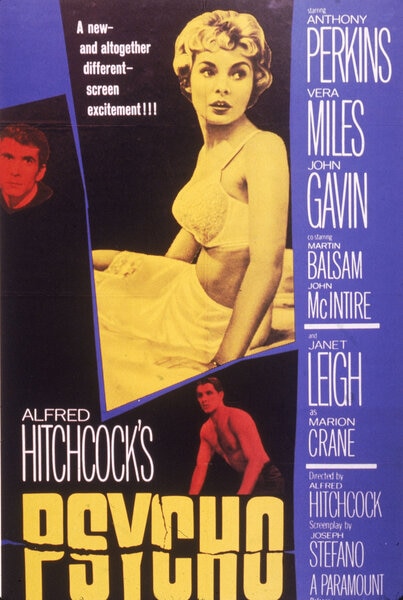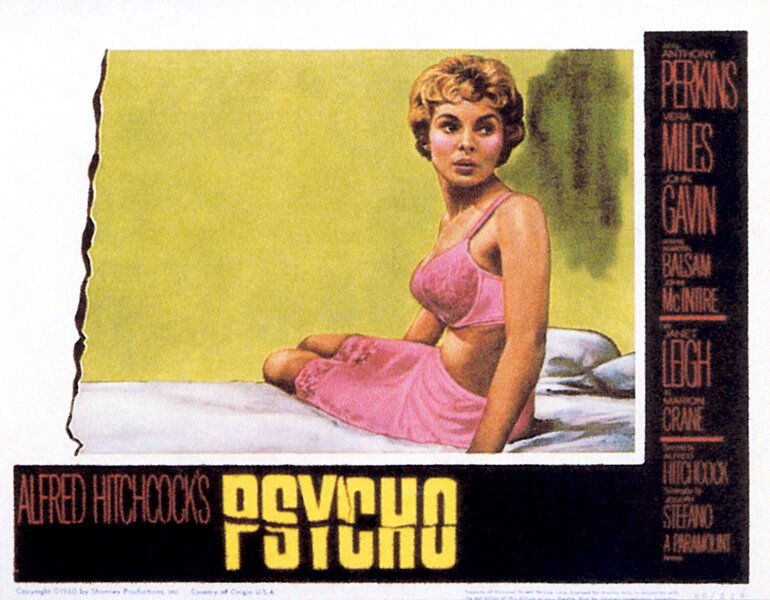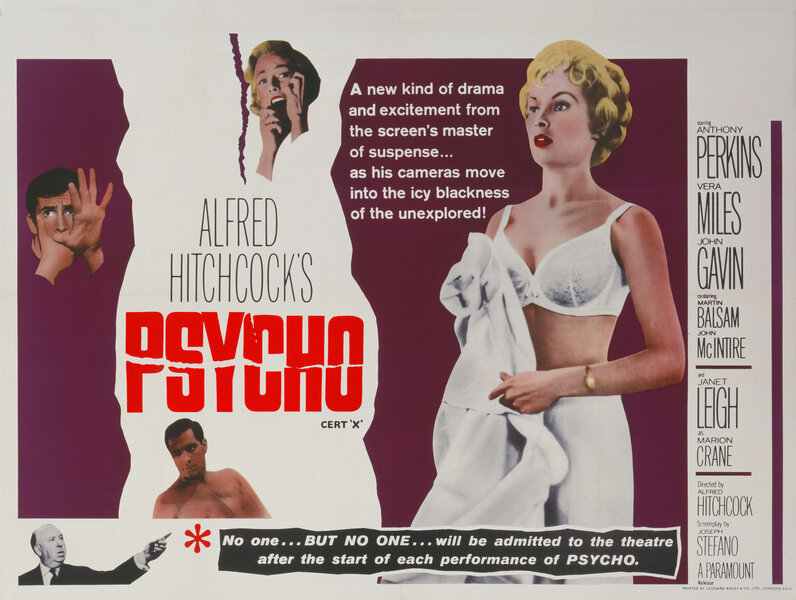Create a free profile to get unlimited access to exclusive videos, sweepstakes, and more!
How Marion Crane's bra sold Psycho

It has been 60 years since Janet Leigh's infamous shower scream was first heard around the world. In the more than a half-century since it first hit theaters, Alfred Hitchcock's Psycho has been dissected, reimagined, and influenced countless filmmakers. Leigh's daughter Jamie Lee Curtis would go on to become the emblematic Final Girl, but her mother laid the foundation for the ultimate slasher trope: you have sex, you die.
The now indelible image of a wet-haired and terrified Leigh, standing against a familiar tiled background, is not the one that was used when the movie first opened nationwide on September 8, 1960. Instead, another titillating shot of Leigh as Marion Crane from the opening scene of the movie features prominently.
"A new — and altogether different — screen excitement!!!" promises the poster. These words appear alongside the chaste (by 21st-century standards) bra and slip shot of Leigh, which dominate the US one-sheet key art. Her concerned eyes look off at an unseen person, while Anthony Perkins and a shirtless John Gavin are bathed in red. Writing about these images decades later, and with an acute awareness of the roles these men play within the narrative, informs the reading. However, it is unclear who the predator is if you ignore preconceived notions. Leigh was already an established star so her placement at the center isn't unusual, but the lack of clothing is.
Frequent Hitchcock collaborator Saul Bass designed the opening credits, but the poster is the work of Tony Palladino. Using the unique typeface Palladino created for the 1959 novel of the same name by Robert Bloch, Hitchcock purchased the rights to the torn-style font, the fractured quality of which seeps into the more cerebral European advertising campaigns. The publicity campaign minimizes the men in the movie, and blowing up the image of Marion in her undergarments ensures all eyes are on her. Sex sells, of course, and this costume sneak peek is setting up the audience for the salacious opening scene.
Hitchcock had a long history of clashing with the figures that implemented the restrictive Motion Picture Production Code (aka, the Hays Code). Crime, sex, and costume were monitored (along with language and religious connotations), which meant nudity couldn't even be suggested and sex between an unmarried couple was taboo. By 1960, this code was in decline but the MPAA still had to approve the cut. Psycho opens with a motel tryst between Marion and her boyfriend Sam Loomis (Gavin). Marion is fed up with how his divorced status impacting the legitimacy of their union, and she wants to live a moral life.
Unfortunately, Sam's dire financial predicament (due to the alimony he has to pay his ex-wife) is an obstacle. In the past, it would've been impossible to show even a married couple in an embrace like this, let alone a lunchtime quickie between an unmarried pair. Matching the image from the posters, Marion is in a state of semi-undress, and the subject of her undergarments was a big topic of discussion between the director, star, and costume team.
In Stephen Rebello's in-depth chronicling of the film, Alfred Hitchcock and the Making of Psycho, he discusses censorship and production conversations about certain costumes. While there is some disagreement about whether Leigh was initially unhappy with the off-the-rack garments — Leigh denies requesting tailor-made underwear noting, "I suggested the half-bra because it was like what I normally wore" — the decision to show her in intimate attire was a considered one.
Off-the-rack garments for a leading lady are not an unusual choice in 2020, but in 1960 this was far from commonplace. Relatability was vital to Hitchcock in Leigh's portrayal of Marion, and the behind-the-scenes tome suggests the director wanted the "underwear to be identifiable to many women all over the country." However, this doesn't negate the provocative nature of this choice. Costume designer Rita Riggs told Rebello, "A bra and slip — even just showing the midriff section — was very racy then and fairly verboten." Hitchcock not only showed off Leigh's midriff on film, he also did so on the poster.
Riggs explains the conversation went "on and on" deciding between the white and black set for the opening sequence, opting for purity before the theft and the "bad girl" imagery after Marion steals the $40,000. Either would be a bold choice for the key art, luring the audience into the picture alongside the "screen excitement" promise. One lobby card image from Paramount changed the white to pink, which reads like an extra dollop of femininity that straddles the line between wholesome and dangerous. The double whammy of the visible bed that Marion sits on is a knowing wink to what has been going on in this location.
Perhaps the original spoiler-phobe, Hitchcock was adamant that latecomers would not be admitted once the film had begun. A different underwear-clad poster promises, "A new kind of drama and excitement from the screen's master of suspense... as his camera move into the icy blackness of the unexplored." Again, these words are placed near Marion's face (and chest), which suggests her perturbed reaction is due to this sentiment.
Hitchcock appears at the bottom of the poster pointing to a mandate he expected all audience members to adhere to, "No one... BUT NO ONE... will be admitted to the theatre after the start of each performance of PSYCHO."
This policy was made very clear to the queuing public via announcement and on banners outside a Broadway theater. What better way to ramp up the tension and hype the audience than with this decree? Newspaper teaser ads told the audience to keep matters secret — even if this April 1960 New York Times piece mentions Leigh meeting her death in a "gory manner." Combined with the provocative poster images, Psycho was the hottest ticket in town.
Psycho opened wide on September 8, 1960, but had been playing in select cities (including New York City) over the summer. Reaction to the "must-see" movie included letters to The New York Times condemning the violence inflicted on a naked woman and Hitchcock's spoiler-free policy. Responses supporting and deriding this critique followed with a page dedicated to the debate surrounding this movie — a conversation that continues regarding violence and nudity on screen. One reader points out that there is no attempt to conceal the themes of the movie, and while the posters focus on Marion's undress, the "icy blackness of the unexplored" statement is pretty indicative of what is to follow.
Sex and horror are intrinsically linked, which often sees the transgressor punished harshly. Marion has sex out of wedlock and then steals money so she can live a moral life. It doesn't matter that she was going to return the cash, because she meets her grisly (and naked) end before she can.
The shower sequence is ingrained in pop culture history, but looking back at the publicity materials reveals how Hitchcock purposefully avoided using that to lure audiences to the theater. He didn't need to spill details of this envelope (and censorship) pushing moment because the posters tapped into the titillation factor instead. 60 years after Psycho's release, Marion's simple white bra and slip is no longer a scandalous clothing option, but these images still have the power to shock — especially now that the audience is no longer in the dark regarding her fate.





























